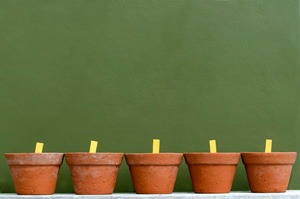Ask Mr. Sage: What Size Pot Is Best for Transplanting Sages?

Dear Mr. Sage,
My new sages from Flowers by the Sea have rested outside in partial shade for a few days and appear to be raring to be planted. I intend to container plant some by themselves and am wondering about the size of pots to choose for upsizing. I don’t want to have to repot them too often, because plants seem to suffer for a few days following the transition no matter how much I water. What do you suggest?
Sincerely,
Concerned Plant Parent
Dear Concerned Plant Parent,
It's great to hear that you are hardening off your Salvias before planting them. This gives them recovery time following the shipping journey. I appreciate your question, which touches on important factors related to repotting — container size, frequency of transplanting, and watering — following this transition period. All three factors affect maintenance of a plant’s root ball, which should never be allowed to dry out completely after repotting. A moist but not soggy root ball is a major key to successful transplantation.
Container Size. At Flowers by the Sea, we ship plants in 3.5-inch plastic pots. Before placing your sage in an ornamental container, you may want to upsize it one or two times in larger plastic containers like the ones in which garden centers sell plants.
The round, black plastic pots for transplanting used by nurseries typically are referred to as one, two-, and three-gallon containers. In addition to volume, diameter is another way that gardeners name pot size. One-gallon pots usually are up to 8 inches in diameter and may be called "8-inch pots."
Keep in mind that diameter for larger pots varies depending on the height of a container. A two-gallon pot that is deeper than a one-gallon pot may be only 8.5 inches in diameter. A taller pot provides more depth for root expansion. But if it is much deeper than a one-gallon pot, it will also drain less efficiently. Selecting a two-gallon pot with a wider diameter may be a better choice for sages due to their need for good drainage.
For container gardening, we typically recommend upsizing our sages gradually and beginning with a move to a one-gallon container. However, if you are repotting a fast-growing plant, such as Bog Sage (Salvia uliginosa) or Rhythm and Blues Anise-Scented Sage (Salvia BODACIOUS® ‘Rhythm and Blues ’), a two-gallon pot may be a better choice.
Frequency of Transplanting. Choosing a two-gallon container for the first upsizing of a fast-growing sage avoids frequent disruption of the plant’s roots. Conversely, a low water, slow-growing sage — such as Windwalker Desert Rose Sage (Salvia WINDWALKER® ‘Desert Rose’) or Giant Purple Desert Sage (Salvia pachyphylla ‘Blue Flame’) — is at risk of being overwatered in a pot containing lots more soil than its original container.
However, frequently transplanting a low water, slow-growing sage to somewhat larger pots may repeatedly disturb its roots and further slow growth. For this kind of plant, it may be best to move it to a one-gallon planter and concentrate watering around its root ball for a week or more.
Watering. The first rule of green thumb about watering for container transplantation is to drench the soil in the original FBTS pot before moving the plant to a larger pot. The second rule is to remember that all transplants need daily doses of H2O until “established” in their new pots, which means until their roots grow into the new media. This is true whether they are water lovers or desert plants, because potting mix in containers dries out faster than in-ground soil.
The third rule, which we've already touched on, is to never let a plant’s root ball completely dry out even if it is a super drought-tolerant sage. When this happens, the soil around the roots becomes hydrophobic and can’t absorb water.
Avoiding hydrophobia for low-water sages requires a careful balancing act of directing water to the root ball without overwatering surrounding potting mix. In contrast, water-loving sages that grow rapidly are better adapted to the overwatering that can occur when a root ball is surrounded by lots of new potting soil.
Finally, all Salvias need well-drained soil so their roots can receive oxygen and stretch out in the air pockets. This means that whatever size of container you use for transplanting should have drainage holes.
Thanks for your question,
Mr. Sage

 Salvia BODACIOUS 'Rhythm and Blues'
Salvia BODACIOUS 'Rhythm and Blues'  Salvia uliginosa
Salvia uliginosa  Salvia pachyphylla 'Blue Flame'
Salvia pachyphylla 'Blue Flame'  Salvia WINDWALKER® Desert Rose
Salvia WINDWALKER® Desert Rose
Comments
There are no comments yet.